Abstract
Diagnosing the activities of a sports organization requires, without doubt, the use of the methodological advantages of a systemic approach. Purpose: This diagnosis was aimed at making an intricate analysis of the sports club in order to detect any deficiencies/problems which might appear in the management process. Methods: The evaluation of the management system was carried out by means of a questionnaire survey, in which the sample, made up of subjects from the Management Department and Technical Department, was invited to assess 10 items, each on a scale from 1 to 5. Also, a PEST analysis and MFSOA matrix were carried out, based on a SWOT analysis. Results: This endeavour leads to the evaluation of their system of management and, at the same time, to actions which can improve the management system of the sports club. Conclusions: Management without solid theoretical foundations and without a systemic vision can lead to syncope within the management system. The organization must have the ability to maintain itself and evolve under the demands of the external environment, as well as the ability to adapt/ readapt to the changes in the internal environment.
Keywords: Management, organization, vision systems
1. Introduction
The increasing complexity of the managerial process has made necessary a systemic approach to
this process. This concept defines the system as “a set of elements organized and based on inter-
conditioning connections the function of which allows certain objectives to be reached” (Burduș, 2007:
21).
Management includes methodological, decisional, informational and organizational components, a
fact which allows it to be treated as a system. Management does not exist without an organization, and
an organisation cannot function without management.
Organizations generate a system of actions from the perspective of the members of the organization
and their actions in different situations. The members of the organization personalize and adapt the
organization according to the situations encountered in the system. The manager and situations
necessitating action together form a logic of action: “The meeting of the manager with a situation leads
to interactions which allow the creation of laws of action” (Amblard et al., 1996).
In the diagnosis of the activities of a sports organization, a methodological approach to the system
is, without doubt, necessary.
The systemic nature of sports organization has been studied since the 1990s, several authors
(Chiffler, 1993; Defrance, 1997; Loret, 1993) addressing the systemic vision of sports organizations in
terms of interdisciplinarity, because management of sports organizations is based on concepts and tools
borrowed from other fields: economic, sociological, managerial.
A systemic vision permits uncovering the components of structural parts, relationships, interactions
and inter-conditioning, which can explain a process, a phenomenon or an activity with the adjustments
and mutual influences responsible for the unit, the coherence of certain actions, or responsible for the
disorder or incoherence of others. A systemic approach leads to emphasis on the dynamics of the
activities.
A systemic vision highlights subordinate and/or superordinate relationships of the different
structures and relationships between the aims of the organization and the results obtained.
In the light of managing a sports organization, a systemic vision is aimed at the function of the
whole, as well as the individual parts of which it is composed, the relationship between the managerial
system and that which is managed, and the dialectical connection between the systems of the
organization, the organizational environment and the orientation towards a specific goal (Livian, 2008:
98).
The systemic approach facilitates the analysis process, but it also permits, thanks to the global
vision, the discovery of a logic to the recommendations made in order to re-stabilise the coherence of
the organization with its environment. Every organization possesses the ability to self-transform, self-
adjust and acquire a certain synergy.
For the success of the organization, the manager must analyse both its internal and external
components. Focusing solely on internal issues can lead to ignoring the environmental conditions
which affect the activities of the organization, or to the lack of ability to recognize the constraints or
opportunities of the employees and the athletes. This is why the manager must focus his actions on
managing the relationships between the organization and its external environment (Donna, 1990: 13),
meaning in fact permanent adjustment of the organization’s activities according to the conditions
presented by the surrounding environment in which the activities are conducted.
Directly related to the environment, the organization provides a transfer of information between the
components that constitute its internal systems and between them and the environment, acting through
its external systems, thus enabling a process of self-regulation of components and relations between
them (Aldea, 2010: 19).
Emphasizing the differences between internal and external factors as determinants of performance
has remained an organizing principle in strategic management (Mihăilescu, 2008: 43).
By studying the literature (Simion, 2009; Frâncu, 2000; Fugigi & Petrache, 2000), we observe
interest in the managerial work of sports organizations. The specific managerial methods used in this
research are found in scientific studies whose objective results generate the tools needed for
redesigning the managerial system.
2. Materials and methods
The diagnosis performed on Chindia Targoviste Football Club included an investigation designed to
evaluate the management applied within the club. 10 members of the Human Resources Department of
the club were investigated, while a SWOT analysis provided us with internal and external information
which was necessary in making the best decisions and founding a development strategy for the
management system. A sports organization contains and functions as a complex, dynamic, open
system, with multiple, varied internal and external connections determined not only by the actions
within the organization, but also the political, economic, social and technological (PEST) influences of
the external environment, this analysis having also been carried out at the aforementioned club.
Following the SWOT analysis, we developed an elaborate matrix of the strengths, weaknesses,
opportunities and threats (MFSOA).
All of these lead to the evaluation of the management system of the club and, at the same time, the
discovery of actions which could improve the club’s system of management.
2.1. Purpose
The research was initiated with the purpose of identifying existing problems in the different
components of the management system and gaining knowledge of the internal and external
environment of the organization, this being considered a premise to the creation of a development
strategy for the system of management in the sports organization.
2.2. Hypothesis
Promoting a systemic vision within the management of a sports organization and performing a
diagnosis of its management system is a necessary course of action in developing a strategy for the
management system of the respective sports organization.
2.3. Methods
In the research, we used the following instruments of scientific research investigation: SWOT
analysis, PEST analysis, MFSOA matrix, and methodological instruments needed to obtain information
deemed necessary to our research.
SWOT analysis - by using this tool, it was performed a diagnosis of the internal and external
environment of the sports organization, meticulously identifying important issues that could lead to
improved managerial work within the football club and to redesigning the studied management system.
The list of problems on internal environment for being analysed has determined the intensity and
importance of each issue (Table 1), by awarding them a value on a scale from 1 to 5, where 1 signifies
very low intensity/ importance, and 5, high intensity/ importance.
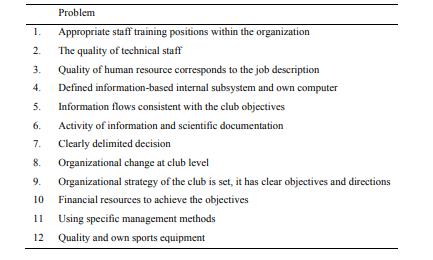
On the issues identified for the external environment, it was determined the likelihood of their
manifestation and their impact on the sports club on a scale from 1 to 5, where 1 means a probability
with very low impact, and 5 a probability with a very big impact (Table 2).
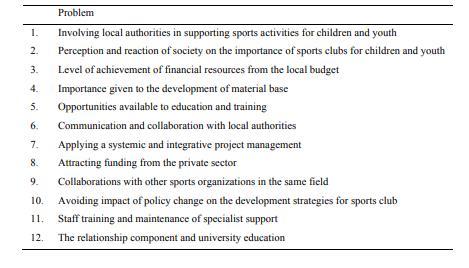
A sports organization is established and operates as a complex, dynamic and open system, with
multiple and diverse internal and external connections determined by the actions within the
organization and the political, economic, social and technological (PEST) influences of the external
environment. To diagnose the management system at the investigated football club, we developed a
matrix of strengths, weaknesses, opportunities and threats (MFSOA) which were identified, in order to
develop the club’s management system. MFSOA matrix was developed by:
combining strengths with opportunities, resulting in a development strategy; combining opportunities with weaknesses, resulting in a growth strategy with risk; combining strengths with threats, resulting in a growth strategy with risk; combining weaknesses with threats, resulting in a reorientation strategy.
MFSOA matrix contains nine squares:
four dials for the four key-factors: strengths, weaknesses, opportunities, threats.
four quadrants for strategic alternatives resulting from the combination of the four basic factors.
3. Results
With regards to the global evaluation of the management system within the researched club, the
score obtained was 2.23, a satisfactory level according to the evaluation scale used.
The SWOT analysis has led to the discovery of different strengths, weaknesses, opportunities and
threats, as presented in the following table:
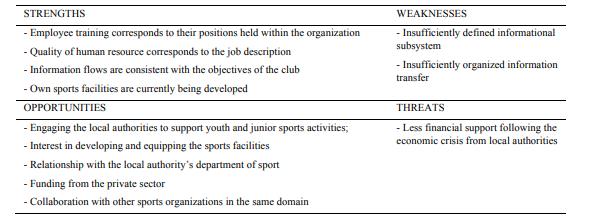
In Table 4, we show the results of the PEST analysis for the club researched.

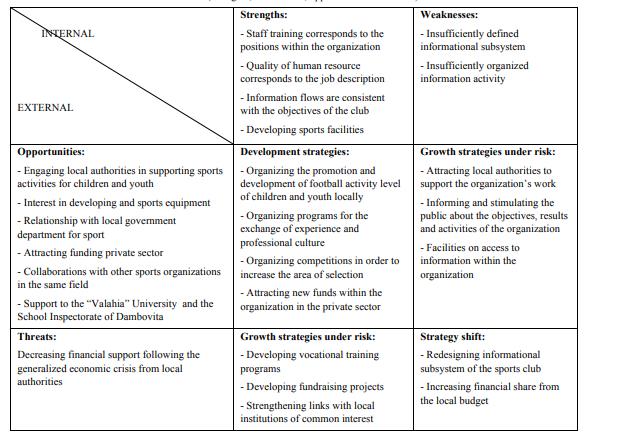
Following the diagnosis of the sports club’s management, we have identified and proposed the
following strategic approaches in order to develop and improve the system of management within the
sports organization.
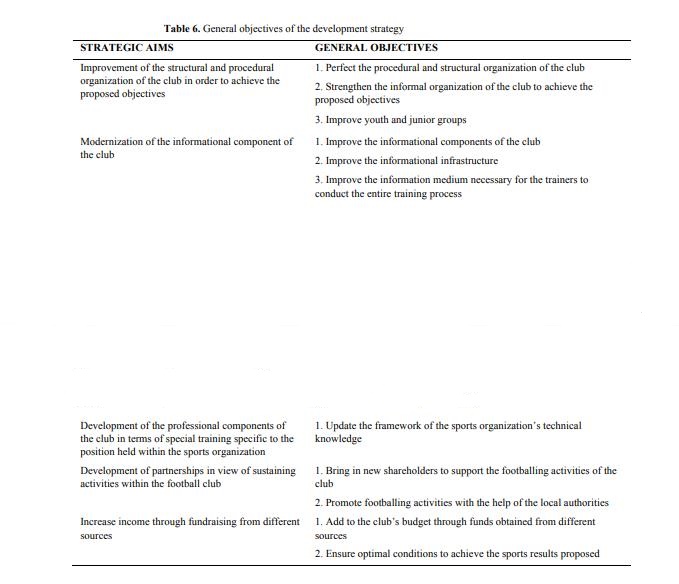
4. Conclusions and discussions
Using the SWOT analysis has led to the identification of the actual situation of the club (Table 3),
where we see an important aspect of strengths: quality human resource as well as a worrying aspect
related to weaknesses: informational subsystem is insufficiently defined and opportunities as well, but
the support of local authorities will lead to the development of sports organization. On the basis of
identified MFSOA matrix (Table 5), we achieved development strategies, growth and reorganization of
risk conditions, which has led to improved process of management. Through the managerial approach
proposed and performed, we find that the methods used are effective and lead to diagnosing the
management system and design strategy for improving the activity of the organization.
Managing without a solid theoretical foundation and without a systemic vision can lead to syncope
within the management system. The organization must have the ability to maintain itself and evolve
under the impact of the demands from the external environment, and adapt/ readapt according to the
changes in the internal environment. The good/ poor functionality of an organization is the result of the
actions, either good or bad, upon the internal and surrounding environment, namely the leadership or
management of it. Thus, the efficiency of an organization depends on the ability of its leader or leaders
to use the internal resources available – material, financial, human and informational, to conform to the
trends and changes which take place and exploit the opportunities presented by the external
environment. Within sports organizations, physical, informational and psychological transformations
take place. This is reflected in the external environment of the organization, constituting ‘inputs’ into
the system of the organization. For these transformations to take place, sports organizations have to
possess the ability to act/ react through its resources and efficient work methods, the results of these
transformations representing the ‘outputs’ of the system. Such a vision is essential in the context of
modern management used within sports organizations for the transformation of recommendations into
operational contexts.
References
Aldea, A. S. (2010). Analiza valorii, metodă de reproiectare/proiectare a sistemului de management al
organizaţiei.Bucureşti: Agir.
Amblard, H., Bernoux, P., Herreros, G., & Livian, Y. F. (1996). Les nouvelles approches sociologiques des
organisations.Paris: Seuil.
Burduş, E. (2007). Fundamentele managementului organizaţiei. Bucureşti:Editura Economică. Chiffler, P. (1993). Associations de sportifs ou entreprises de sport.Paris. Defrance, J. (1997). Sociologie du sport (2e édition).Paris: La Découverte.
Donna, W. (1990). Business and Society.Harper Collins Publishers.
332
eISSN: 2357-1330 Selection and peer-review under responsibility of the Organizing Committee
Frâncu, E. (2000). Rolul managementului în determinarea obţinerii performanţei sportive. Ştiinţa Sportului,
17.
Fugigi, P. C., & Petrache, A. (2000). Atribuţiile funcţiei de manager al echipei naţionale de rugby. Ştiinţa
Sportului, 17.
Livian, Y. F. (2008). Organisation. Théories et pratiques.Paris: Dunod.
Loret, A. (1993). Sport et management. De l’éthique á la pratique.Paris: Dunod.
Mihăilescu, N. (2008). Organizare şi conducere în structurile sportului. Piteşti: Editura Universităţii din Piteşti.
Simion, C. D. (2009). Dezvoltarea handbalului pe plan european prin îmbunătăţirea activităţii manageriale. (Teză de doctorat).ANEFS, București.
Copyright information

This work is licensed under a Creative Commons Attribution-NonCommercial-NoDerivatives 4.0 International License.
About this article
Publication Date
10 June 2016
Article Doi
eBook ISBN
978-1-80296-010-5
Publisher
Future Academy
Volume
11
Print ISBN (optional)
-
Edition Number
1st Edition
Pages
1-509
Subjects
Sports, sport science, physical education
Cite this article as:
Cucui, G. G. (2016). Systemic Vision – Its Necessity in the Management of Sports Organizations. In V. Grigore, M. Stanescu, & M. Paunescu (Eds.), Physical Education, Sport and Kinetotherapy - ICPESK 2015, vol 11. European Proceedings of Social and Behavioural Sciences (pp. 326-333). Future Academy. https://doi.org/10.15405/epsbs.2016.06.45

